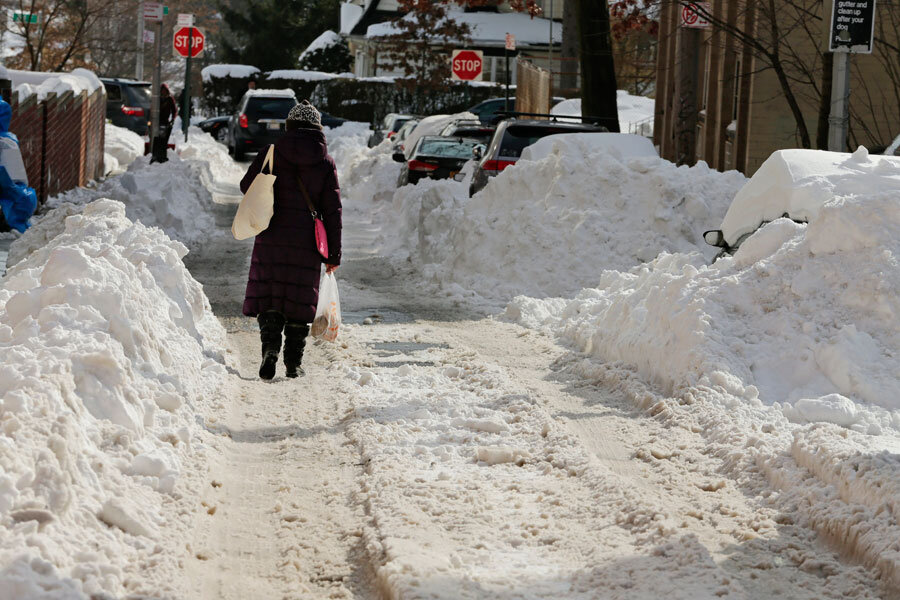Throw away the shovel: How electric concrete melts snow
Loading...
For commuters negotiating post-blizzard conditions, take heart: electric snow-melting concrete may be coming to a city near you.
Dr. Chris Tuan, a professor of civil engineering at the University of Nebraska-Lincoln, and his team of researchers have developed a concrete mixture prototype that melts away falling snow and ice by conducting electricity.
Steel rods beneath the concrete’s surface connect to electrodes, which connect to a 120-volt AC power source. Carbon byproducts from coal mining and steel shavings from industrial waste make up only 20 percent of the otherwise typical concrete mixture, but the conductivity is strong enough to clear the surface.
“We keep it barely above freezing… somewhere around 40 degrees,” Dr. Tuan tells National Geographic, saying it doesn’t take much heat to make the concrete ice-free. “It doesn’t get hot at all.”
Ice-melting concrete has been researched for decades. Tuan is enthusiastice about his new prototype, however, because it reduces costs by 60 percent compared to earlier trials.
Still, it’s not cheap: Tuan’s concrete runs $300 per cubic yard, compared to $120 per cubic yard of regular concrete.
But the typical salt and de-icing chemicals used on streets can corrode concrete and lead to potholes. Tuan said this makes his conductive concrete an even more attractive option, with a greater upfront price tag offsetting later maintenance and operating costs.
“Bridges always freeze up first, because they’re exposed to the elements on top and bottom,” Tuan told UNL Today. “It’s not cost-effective to build entire roadways using conducive concrete, but you can use it at certain locations where you always get ice or have potholes.”
In 2003, Tuan installed a conductive concrete system on the 150-foot Roca Spur highway bridge in Lincoln, Neb. He said that it cost $250 to de-ice the bridge during a three-day storm, far less than the usual costs of plowing, chemicals and subsequent road damage.
“Statistics indicate that 10 to 15 percent of all roadway accidents are directly related to weather conditions,” Tuan explains in his 2008 analysis of the bridge study. “This percentage alone represents thousands of human injuries and deaths and millions of dollars in property damage annually … The conductive concrete deicing technology is readily available for implementation at accident-prone areas such as bridge overpasses, exit ramps, airport runways, street intersections, sidewalks and driveways.”
And along with bridges, Tuan sees serious potential for his invention at airports.
Tuan and his team of researchers are in a test phase with the Federal Aviation Administration (FAA) through March. And if the FAA is satisfied with the results of Tuan’s electric concrete, they will move on to test the product at a major airport.
Tuan said he is surprised to hear the FAA isn’t as worried about the runways – they are hoping the concrete is effective on the tarmacs.
“What they need is the tarmac around the gated areas cleared, because they have so many carts to unload – luggage service, food service, trash service, fuel service – that all need to get into those areas,” Tuan explains to UNL Today. “They said that if we can heat that kind of tarmac, then there would be (far fewer) weather-related delays. We’re very optimistic.”
As for energy usage, Tuan argues that his product actually helps the environment.
His system takes about 13 watts of energy per square foot, far less than the typical 60-watt incandescent light bulb. And in the future, Tuan said he wants to develop sensors that would allow the concrete to turn on only during a storm, and then off when they are no longer needed.
Conductive concrete can alleviate environmental damage by reducing the amount of salt and chemicals dispersed on roads and sidewalks after storms. Melting snow and ice carries deicing chemicals into local waterways and nearby soils, which in turn can slow plant growth and attract animals into dangerous roadways.
And Tuan takes his work home with him: ten years ago, he installed one of his first pilot systems in the patio of his Nebraskan backyard.








